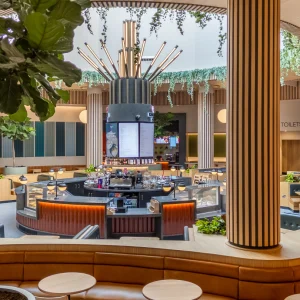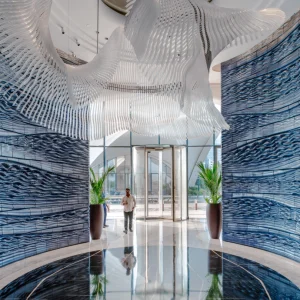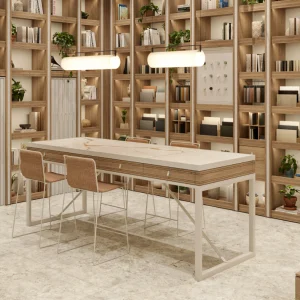THERE IS NO DOUBT that one of the strongest developments in lighting in recent years has been the experimentation, and increasing sophistication, of optics. Technically, once the source becomes pretty well universal the direction of travel is the refinement of the technology (Flos’s extended LED filament) and the management of the light it produces (microprismatic diffusers such as Artemide’s Discovery and their evolving applications). But as was evident at this year’s Salone del Mobile, it’s not all about the gubbins, especially in Milan, aesthetically eclectic as ever. Minimalism rubbed shoulders with maximalism, the classics (some revisited) with the contemporary, traditional crystal with the clean-lined – literally in the case of Lasvit’s Bois de Cristal.
Eclectic Exhibits
This year’s Salone del Mobile in Milan showcased a wide variety of lighting solutions – from a taste of retro to the
colourfully artistic…
LASVIT
Bois de Cristal / Maria Culenová

Bois de Cristal is a modular design concept fusing handmade glass with bent plywood. It features 18 modular arms, each made from a combination of handmade glass, bent plywood and copper wire used in place of cables, designed to mimic the natural forms found in dense jungles. The LED source sits at the junction of wood and glass.
‘The concept aims to bring the outdoors inside, blending the warmth of wood with the luminosity of glass,‘ says Maria Culenová, Lasvit’s senior designer. ‘The design features gracefully flowing lines that stand out individually but also in a more complex composition.’ www.lasvit.com
ARTEMIDE
Wish You Were Here / Carolina Gismondi de Bevilacqua

Given the Compasso d’Oro prize in 2018 – Italy’s oldest design award – Artemide’s patented optical principle Discovery has been applied to a whole range of product concepts, including the latest, Wish You Were Here. Whatever the product, the micro-optic di user appears almost invisible until the light is switched on. The LEDs in the outer rim then inject light into the central diffuser surface. This also ensures both a precise light output and visual comfort. Until now it has been used two-dimensionally – the flat disc of the Suspension pendant version for example – but Wish You Were Here folds the surface of the transparent plate to create a tabletop structure. Measuring 260x156x216mm, the luminaire basically is the diffuser, apart from the slim bar at the top for the cable housing, available in silver, bronze or black finish.
Lune d’acqua / Benedetta Tagliabue, Ersilia Vaudo

The sphere at the centre is held by two rings, and is free to spin suspended at the centre of their intersection. The ring that encloses the sphere houses the LEDs that inject light into the internal surface. When switched off, it remains transparent. Once illuminated, it becomes animated with light emitted through micro-incisions, revealing the soft and three-dimensional wave of its geometry.
The rings play a structural role, propping up the central core on a tilted axis, and adding dynamism and re-lections on their polished, mirrored surfaces. The focus is on the relationship between the central light and the shadows it casts in the surrounding space. It is sizeable: the sphere’s diameter is 350mm, and it measures 370x550x440mm overall. www.artemide.com
DAVIDE GROPPI
Stop / Davide Groppi
 Image Credit: Davide Groppi Srl
Image Credit: Davide Groppi Srl
Groppi is all about minimalism but he’s also a very graphic designer. He has said that in another life he might have been a mathematician, an ambition manqué evident in the pure lines and geometric precision of many of his designs. Stop is the self-explanatory name of his latest floor lamp, a simple round base in matt black painted steel, a slim stem in polished chromed brass, and a full point of a head in Gravity Black matt-black painted steel. The disc-shaped head is adjustable.
Ribbon / Maurici Ginés
 Image Credit: Davide Groppi Srl
Image Credit: Davide Groppi Srl
The desk or table lamp Ribbon by Davide Groppi is a doodle in the air or, as designer Maurici Ginés has it, ‘the ribbon is a symbol of union and continuity’. The base is black marble, the arms in matt-black painted aluminium, connected by a black silicone pipe. A particularly strong joint allows the lamp to be positioned along the vertical axis. The light can also be adjusted around the base.
Simply touching the sensor at the end of the upper arm will switch the light on and off and adjust the brightness. www.davidegroppi.com
MARSET
Konoha / George Yabu and Glenn Pushelberg

Konoha is a straightforward idea cleanly and elegantly executed. Designed for hotel rooms, it combines ambient and direct light in one fitting.
A simple, understated wall lamp features a shade over a spotlight that turns through 360°. The spotlight can be directed upwards, the beam deflecting off the shade interior to create warm, indirect ambient lighting. Alternativel, the spotlight can be focused downwards, projecting a beam of direct light, turning the fixture into a reading lamp.
The design is available in a range of colours, with neutral and organic shades. It could also be used as a reading lamp in waiting rooms, or provide a point of light in walkways, a wall lamp in restaurants, or a way to bring ambient lighting to hotel entrances. www.marset.com
DANESE
Spettatori / Mimmo Paladino

Spettatori is in a long line of arty lighting that allows the user to fiddle about with it and create their own compositions. Fashioned by sculptor and painter Mimmo Paladino, Spettatori represents the heads of spectators, at the cinema or theatre, illuminated by the show or projection in the darkness of the space.
Three or five-head profiles made of mould-cast glass in different colours are connected by a structural but pliable cable that powers the LEDs that backlight them.

The heads can be freely positioned, the cable connecting them shaped according to their arrangement on the surface to which they are attached. www.danesemilano.com
FLOS
Superwire
 Image Credit: Roger Rieger
Image Credit: Roger Rieger
Flos’s Superwire is a distinct nod to the Art Deco period. A family of modular lamps designed by Formafantasma for Flos, the range ‘recalls the work of the great glass masters of the last century’.
This is not pastiche, however. The aim was not artisan but an amalgamation of elegant and industrial. ‘We wanted to steer away from the idea of craftsmanship and get closer to an industrial aesthetic, albeit decorative, because this is a mass-produced lamp,’ says Formafantasma. ‘For this reason we chose planar, industrial glass and a geometric look, with the mechanical constituent elements – base, top and screws – remaining visible. That also serves to facilitate disassembly and replacement of the light source when necessary.’
So far available in table and pendant versions, the luminaires are made up of one or more hexagons of planar glass connected by an aluminium element. The source was specially developed by Flos, based on the filament in LED lamps, which recalls the filament in an incandescent bulb. A very thin, flat, soft, flexible LED strip measuring up to 1m, it emits a warm, homogeneous light along its entire length. The technical challenge lay in its atypical length (filaments are usually no longer than 30cm). An added virtue is that it can be easily removed for replacement and repair.
The basic module is a hexagon that emits light along its length (45cm for the table model, 75cm for the others), the six sides formed by glass sheets that house three bright straws each. Each straw is a combination of three cylinders (two centerers with high diffusion efficiency and a borosilicate diffuser) inserted into each other. In the centre is the LED filament that allows 360° light emission.
The glass sheets are held together at the base and in the upper part, by a hexagonal element in aluminium with large exposed steel screws. These two metal plates allow the multiple modules to be put together to create different versions.
Taking The Tube
A look at the life and work of Dan Flavin in light of a new retrospective at the Kuntsmuseum in Basel
THE FLUORESCENT TUBE was never a lovable source. Its association with uniformity, industry and the workaday make it at first glance an unlikely medium for art. But US artist Dan Flavin, part of the minimalist school that included Donald Judd and Sol LeWitt, famously transmuted it into a tool for artistic expression, using it to distort space, blur spatial borders and play with visual perception.
He juxtaposed tubes of different colours (or the same colour), positioning them singly or in choreographed clusters, angled, vertical and horizontal. He stood them in corners, created compositions on walls and constructed entire freestanding structures that ran the length of a gallery space.
 Untitled (To a Man, George McGovern) 2, 1972 – warm white fluorescent light. First shown at Leo Castelli Gallery in New York, the work was dedicated to Democrat presidential candidate George McGovern, who ran against Republican Richard Nixon in 1972. The exhibition opened just three days before the presidential election which McGovern lost. Guggenheim Abu Dhabi
Untitled (To a Man, George McGovern) 2, 1972 – warm white fluorescent light. First shown at Leo Castelli Gallery in New York, the work was dedicated to Democrat presidential candidate George McGovern, who ran against Republican Richard Nixon in 1972. The exhibition opened just three days before the presidential election which McGovern lost. Guggenheim Abu Dhabi
His installations trigger visceral sensations through the effect of light, bathing surfaces and somehow the space itself with vivid colour. What makes his structures more complex is not only the radiant light that emanates from them but also the subtle coloured shadows, the penumbra and play of colour on colour.
Birmingham’s Ikon Gallery, which held a retrospective of Flavin’s work in 2016, described one characteristic corner work (Pink Out of a Corner, to Jasper Johns, 1963), an 8ft lamp between two walls, as ‘eradicating darkness from the extremity of the room to the point of obliterating any proper perception of it.
‘Flavin was very aware of the traditional placement of religious icons in corners, like the Russian constructivist Kazimir Malevich, known for his black squares,’ continues the gallery description, ‘but instead he made icons of light, with what he referred to as “blank magic”.’
Born in New York in 1933, Flavin returned from military service in Korea, where he had begun studying art, to take up art history at the New School. In 1959, he took drawing and painting classes at Columbia University. He began with drawings and small paintings in gestural abstract expressionist styles (a term used to describe the work of Jackson Pollock and William de Kooning among others) and small constructions using found objects. His first one-man exhibition was at the Judson Gallery, New York, in 1961.
But that same year he began to make ‘icons’, which combined electric lights with plainly painted square-fronted constructions. In 1963 these evolved into his work with fluorescent tubes. The Diagonal of Personal Ecstasy, created in May 1963, a yellow fluorescent placed on a wall at a 45° from the floor, was Flavin’s first mature work and marked the beginning of his exclusive use of commercially available fluorescent light as a medium.
He confined himself to a limited palette (red, blue, green, pink, yellow and ultraviolet, together with four different whites) and linear forms (straight 2ft, 4ft, 6ft and 8ft tubes) and, beginning in 1972, circles. He eventually started to reject studio production in favour of site-specific ‘situations’ or ‘proposals’ (as he preferred to call them). His first full installation piece, Greens Crossing Greens (to Piet Mondrian Who Lacked Green), was for an exhibition at the Van Abbemuseum, Eindhoven, Netherlands, in 1966.
The title of the latest exhibition featuring his work, Dan Flavin: Dedications in Lights, reflects that, while often untitled, his work was frequently dedicated to fellow artists and people he admired, or were expressions of social consciousness. ‘His pieces, although initially without clearly recognisable signature, frequently make reference in their titles to concrete events, such as wartime atrocities or police violence, or are dedicated to other artists,’ says the museum
 Dan Flavin, pictured in New York in 1970. Image Credit: Gianfranco Gorgoni © Maya Gorgoni
Dan Flavin, pictured in New York in 1970. Image Credit: Gianfranco Gorgoni © Maya Gorgoni
Flavin categorised his various ideas according to the spaces they inhabited, using terms such as ‘corners’, ‘barriers’ and ‘corridors’. Barriers, says online gallery Ideel Art, ‘created artificial divisions in space, causing light to act as both the focus of and the disruptor of the viewer’s experience’.
Corridors were designed to manipulate and impede the movement of the viewer through the gallery space, and also control how the structure was viewed from each side. The first such corridor was constructed for a 1973 solo exhibition at the St Louis Art Museum. Green and Yellow, it features a gap (the width of a single ‘missing’ fixture) that reveals the cast glow of the colour from beyond the divide. In subsequent barred corridors, Flavin introduced regular spacing between the individual fixtures, increasing the visibility of the light and allowing the colours to mix.
 Pink Out of a Corner (to Jasper Johns), 1963 – pink fluorescent light. Stephen Flavin / 2024, ProLitteris, Zurich. The Museum of Modern Art, New York, Gift of Philip Johnson. Image Credit: Florian Holzherr
Pink Out of a Corner (to Jasper Johns), 1963 – pink fluorescent light. Stephen Flavin / 2024, ProLitteris, Zurich. The Museum of Modern Art, New York, Gift of Philip Johnson. Image Credit: Florian Holzherr
By 1968, Flavin had developed his sculptures into room-size environments of light. In that year, he outlined an entire gallery in ultraviolet light at Documenta 4 in Kassel, Germany. In 1992, Flavin’s original conception for a 1971 piece was fully realised in a site-specific installation that filled the Guggenheim Museum’s entire rotunda for the museum’s reopening.
 Untitled (to You, Heiner, with Admiration and Affection), 1973 – green fluorescent light. Stephen Flavin / 2024, ProLitteris, Zurich. Bayerische Staatsgemäldesammlungen – Sammlung Moderne Kunst in der Pinakothek der Moderne München. Image Credit: Florian Holzherr
Untitled (to You, Heiner, with Admiration and Affection), 1973 – green fluorescent light. Stephen Flavin / 2024, ProLitteris, Zurich. Bayerische Staatsgemäldesammlungen – Sammlung Moderne Kunst in der Pinakothek der Moderne München. Image Credit: Florian Holzherr
As his reputation grew, he was given access to an expanding and varying range of spaces in which to exhibit. This enabled him to explore more deeply the way his light compositions could affect the nature of architectural space. Sites for Flavin’s architectural ‘interventions’ included Grand Central Station in New York (1976), Hamburger Bahnhof in Berlin (1996), and the Chinati Foundation in Marfa, Texas (2000). His large-scale work in coloured fluorescent light for six buildings at the Chinati Foundation began in the early 1980s, although the final plans were not completed until 1996.
 Alternate Diagonals of March 2, 1964 (to Don Judd), 1964 – red and yellow fluorescent light. Stephen Flavin / 2024, ProLitteris, Zurich. The Dan Flavin Estate, courtesy David Zwirner. Image Credit: Florian Holzherr
Alternate Diagonals of March 2, 1964 (to Don Judd), 1964 – red and yellow fluorescent light. Stephen Flavin / 2024, ProLitteris, Zurich. The Dan Flavin Estate, courtesy David Zwirner. Image Credit: Florian Holzherr
His last artwork was a site-specific work at Santa Maria Annunciata in Chiesa Rossa, Milan, a 1930s church designed by Giovanni Muzio. The design for the piece was finished two days before Flavin’s death in November 1996. Its installation was completed one year later with the assistance of the Dia Center for the Arts and Fondazione Prada.
 ‘Monument’ 7 for V Tatlin, 1964 – cool white fluorescent light. Stephen Flavin/2024, ProLitteris, Zurich. Bayerische Staatsgemäldesammlungen – Sammlung Moderne Kunst in der Pinakothek der Moderne München, 2002 von PIN. Freunde der Pinakothek der Moderne. Image Credit: Florian Holzherr
‘Monument’ 7 for V Tatlin, 1964 – cool white fluorescent light. Stephen Flavin/2024, ProLitteris, Zurich. Bayerische Staatsgemäldesammlungen – Sammlung Moderne Kunst in der Pinakothek der Moderne München, 2002 von PIN. Freunde der Pinakothek der Moderne. Image Credit: Florian Holzherr
Flavin’s famous statement, ‘It is what it is and it ain’t nothing else’, summed up his belief that his artworks referred to nothing but their factual presence, accentuating industrial materials and intense colour. It was an approach he shared with close friend Donald Judd to whom he dedicated a number of works.
 Untitled (To My Dear bitch, Airily) 2, 1984 – blue and green fluorescent light. Bayerische Staatsgemäldesammlungen – Sammlung Moderne Kunst in der Pinakothek der Moderne München, 2002 von PIN. Freunde der Pinakothek der Moderne. Image Credit: Florian Holzherr
Untitled (To My Dear bitch, Airily) 2, 1984 – blue and green fluorescent light. Bayerische Staatsgemäldesammlungen – Sammlung Moderne Kunst in der Pinakothek der Moderne München, 2002 von PIN. Freunde der Pinakothek der Moderne. Image Credit: Florian Holzherr
Flavin’s influence has found its way into countless interior concepts and architectural spaces. Office lobbies have seen fluorescent tubes suspended vertically from the ceiling in clusters, while from dingy subway to dismal car park, the coloured tube – nowadays LED rather than fluorescent – has brought art to unloved and unlived urban spaces.
 Untitled (to Don Judd, Colorist) 1-5, 1987 – fluorescent light. Stephen Flavin / 2024, ProLitteris, Zurich. Panza Collection, Mendrisio. Image Credit: Florian Holzherr
Untitled (to Don Judd, Colorist) 1-5, 1987 – fluorescent light. Stephen Flavin / 2024, ProLitteris, Zurich. Panza Collection, Mendrisio. Image Credit: Florian Holzherr
‘One might not think of light as a matter of fact, but I do,’ said Flavin. ‘And it is… as plain and open and direct an art as you will ever find.’





